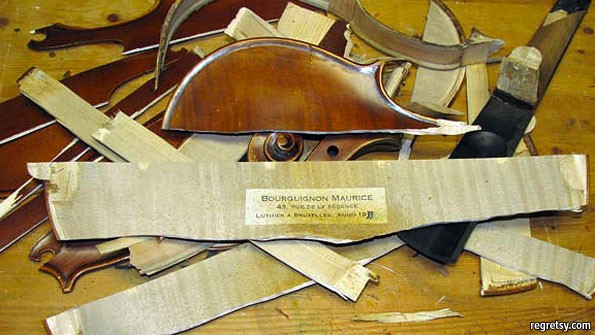How Reliable are Labels in Identifying a Violin s Origins
Post on: 16 Март, 2015 No Comment

STAY CONNECTED
Labels can be misleading and frustrating, but you can learn to read their authenticity (sort of)
By Erin Shrader posted May 2006
Just the other day, another Strings reader wrote inquiring about the value and authenticity of his violin. Like most readers who write to us trying to eek out information about a mystery fiddle, he carefully transcribed the faded, dusty label visible through the f-hole on the bass side: “Joseph Rocca fecit Premiato di Medaglie alle Esposizione di Torino, Genova, Londra Parigi Taurini anno Domini 1858 HIS.” Some of the words may be misspelled, he added, “as the label is kind of faded.”
It often comes as a surprise to learn how unreliable that paper label pasted inside your instrument can be in identifying an instrument’s maker, age, and place of origin. “Labels are as changeable as a pair of shoes,” quips Kerry Keane of Christie’s auction house. Even if the little tag inside your instrument is original, the information printed on it might be accurate but obscure, genuine but inaccurate, misleading, or downright false. A cursory investigation of the Rocca label provides an illustration.
Using a few key words as search parameters, the Internet turned up several instruments bearing the same label. Among them, a genuine Joseph Rocca, certified by a famous dealer and sold by a reputable auction house. The auction record for a violin by this maker is $207,757, set in 1999.
Clearly Rocca is a highly desirable maker.
A second violin bearing the same label was made by John Lott, perhaps the best of the English makers. Lott is famous for making copies so like a master makers’ work that they have passed the scrutiny of very well-regarded experts undetected. Whether to call them forgeries, rather than copies, is debatable, as forgery implies the intent to deceive. Lott being a fine maker in his own right, his violin sold at auction in 1994 for $26,450.
A third instrument with a Rocca label sold recently at Skinner’s, catalogued simply as modern, Genoa school. “I do remember that,” writes Skinner’s specialist, David Bonsey in an email. “It was a modern violin, looked a bit German. It had been everywhere, including a Christie’s sale, where it passed. It was all over New York and had several attributions to Enrico Rocca (Genoa) [Joseph’s son], some from good people, to which I have no comment. In the end, it had just enough quality going for it that it sold to a dealer on spec that it was Enrico.”
The price at Skinner’s that day was $7,931—a good investment if it pans out, as Enrico Rocca instruments have sold as high as $79,000 at auction.
So, using the label alone to answer the reader’s question, could it really be a Rocca? Possible answers are “yes,” “no,” and “maybe, but not the same Rocca inferred by the label.”
As this one example illustrates, labels are hardly a reliable guide to identifying an instrument.
HISTORICAL MISLABELING
Mislabeling of instruments goes back nearly as far as the violin family itself, as chronicled by the legendary Hill family dealers in their book Antonio Stradivari, His Life and Work (London, 1902). In 1685 a court violinist petitioned his employer, the Duke of Modena, for relief as a victim of label fraud. Tomasso Antonio Vitali purchased a violin bearing the label of the great Nicolo Amati for the sum of nine pistoles, only to find that behind the master’s label was that of his pupil, Francesco Ruggieri. Ruggieri’s instruments sold for a mere three pistoles at the time.
“Your petitioner has consequently been deceived by the false label and appeals to Your Most Serene Highness. ” the victimized violinist implored.

According to the Hills, it was common for a maker to insert the label of his master into his own violins. On the one hand, they defend the practice, saying there was no intent to deceive, since the follower usually included his own label or mark—just not in the usual, easily visible place. On the other hand, the Hills later describe the behavior as “injudicious and also objectionable.”
The reasons for mislabeling have to do with economics. Very early on, violins became collectors’ items and have been priced as such. Some makers are more highly collectible than others. Two instruments may perform equally well, but the one with the famous name will command a higher price on the market. Our court violinist Vitale was a discerning professional and founder of his own music school. The violin he bought must have met his playing standards, but he was willing to pay significantly more to own an Amati.
Violins are also valued as antiques. In Vitale’s day in the 17th century, the Amati was worth four times the Ruggieri. Looking at auction results for both makers, the value gap between them has narrowed over the centuries; from this vantage point they are antiques of a similar vintage. But then, as now, Amati’s instruments commanded the higher price.
Even the most ancient and desirable of makers has been the victim of label fraud. Unscrupulous sellers altered the dates on some of Stradivari’s earlier and later instruments to satisfy the market for works from his so-called Golden Period, perceived as more desirable.
Dear Visitor,
This article, How Reliable are Labels in Identifying a Violin’s Origins?, is part of the Strings Archive, which you can access with a paid site subscription.
If you have a paid subscription, you are seeing this message because you have not logged in.














